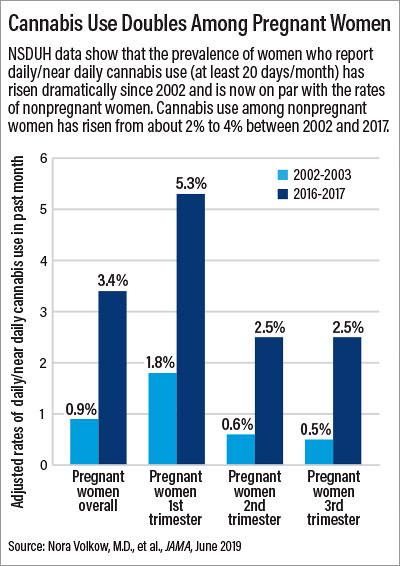Cannabis Use During Pregnancy on the Rise
Abstract
Overall cannabis use during pregnancy has roughly doubled since 2002, but the number of women who use cannabis daily or near daily has risen even more.
As more states have made cannabis recreationally or medically legal, it is not surprising that more adults report using cannabis. However, the increasing prevalence of cannabis use in one population might be somewhat unexpected: pregnant women.
As reported in JAMA this past June by National Institute on Drug Abuse (NIDA) Director Nora Volkow, M.D., and colleagues, cannabis use during pregnancy more than doubled in the United States between 2002 and 2017. Data from the most recent National Survey on Drug Use and Health (NSDUH) revealed that the prevalence of past-month cannabis use increased from 3.4% to 7% among pregnant women overall and from 5.7% to 12.1% among women during their first trimester.
The rates of daily or near-daily cannabis use during pregnancy increased even more, going from 0.9% to 3.4% among pregnant women overall and from 1.8% to 5.3% during the first trimester (see chart).

“There is this growing social acceptability about cannabis in general. And on top of that, one can find messages in online media or even at some cannabis dispensaries touting the benefits of cannabis for pregnancy symptoms like nausea,” said Kelly Young-Wolff, Ph.D., M.P.H., a research scientist with Kaiser Permanente Northern California. Young-Wolff, who has conducted several studies into cannabis use among women, also noted that many pregnant women say they use cannabis to manage their mood in addition to physical symptoms.
A study her team recently published in JAMA Network Open corroborates the NSDUH findings. An analysis of health data from pregnant women enrolled in Kaiser Permanente Northern California found cannabis use during pregnancy increased from 2.0% in 2009 to 3.4% in 2017, with the number of women reporting daily use rising the fastest, from 0.3% to 0.7%. The lower prevalence rates here compared with the national data are likely due to multiple factors, including a different makeup of respondents and that fewer women may be willing to disclose cannabis use in health care settings compared with an anonymous survey.
The widespread legalization of cannabis across the country begs another question: Is marijuana use during pregnancy actually increasing or are more women simply more comfortable disclosing their marijuana use? A separate study conducted by Young-Wolff in 2017 suggests that the prevalence increase is likely genuine. Using urine samples to confirm cannabis use in pregnant women, the researchers found that cannabis use almost doubled from 4% in 2009 to 7% in 2016.
The question now becomes how to deal with this increased use. Research evaluating the potential negative effects of marijuana on pregnancy outcomes has not kept up with rapidly expanding legalization and access to cannabis products, noted Torri Metz, M.D., a professor of obstetrics and gynecology at the University of Utah who co-wrote an editorial for Young-Wolff’s recent study. However, the limited data do suggest cannabis use can lead to preterm births, low birth weight, and possibly even neurological problems in newborns. “As clinicians, we must remind reproductive-aged women that there are no known benefits of marijuana use in pregnancy and that there are associated harms,” wrote Metz and co-author Elaine Stickrath, M.D., of Denver Health and Hospital.
If there is some good news from the recent data, it’s that most of these women are not initiating cannabis use during pregnancy. Young-Wolff’s study assessed cannabis use both during and in the year prior to pregnancy and found that over 96% of the women who reported cannabis use during pregnancy were also using prior to pregnancy. This means that doctors and other health care professionals have plenty of opportunity prior to pregnancy to discuss the risks of cannabis use with women.
“It’s important that [these] data be used to educate but not exploit any women,” Young-Wolff told Psychiatric News, referencing the unfortunate research history of cocaine use in pregnancy that produced the enduring racist trope of the “crack baby.” (An editorial touching on this topic was recently written by Michael Silverstein, M.D., of Boston Medical Center and colleagues, also in JAMA.)
“Pregnant women are trying to do the best that they can during a difficult period, and it’s on us to give them the tools to make informed decisions without added stigma,” she continued.
Young-Wolff’s study was supported by a career development award from NIDA; the NSDUH study was jointly sponsored by NIDA and the Substance Abuse and Mental Health Services Administration. ■
“Self-Reported Daily, Weekly, and Monthly Cannabis Use Among Women Before and During Pregnancy” is posted here. An accompanying editorial, “Is Increasing Frequency of Marijuana Use Among Women of Reproductive Age a Cause for Alarm?,” is posted here. “Self-Reported Medical and Nonmedical Cannabis Use Among Pregnant Women in the United States” is posted here. The accompanying editorial by Silverstein and colleagues, “Cannabis Use in Pregnancy: A Tale of 2 Concerns,” is posted here.“Trends in Self-Reported and Biochemically Tested Marijuana Use Among Pregnant Females in California From 2009-2016” is posted here.



